
| Version | Summary | Created by | Modification | Content Size | Created at | Operation |
|---|---|---|---|---|---|---|
| 1 | Fahrul Nurkolis | -- | 4926 | 2023-09-26 12:26:06 | | | |
| 2 | Rita Xu | -3 word(s) | 4923 | 2023-09-27 04:50:49 | | |
Video Upload Options
Obesity is a global issue faced by many individuals worldwide. However, no drug has a pronounced effect with few side effects. Green tea, a well-known natural product, shows preventive effects against obesity by decreasing lipogenesis and increasing fat oxidation and antioxidant capacity. In contrast, other natural products are known to contribute to obesity. The natural products were classified as single compounds, foods, teas, fruits, herbal medicines—single extract, herbal medicines—decoction, and herbal medicines—external preparation. Then, the mechanisms of these medicines were organized into lipid metabolism, anti-inflammation, antioxidation, appetite loss, and thermogenesis. This research aimed to assess the efficacy and mechanisms of effective natural products in managing obesity. Several clinical studies reported that natural products showed antiobesity effects, including Coffea arabica (coffee), Camellia sinensis (green tea), Caulerpa racemosa (green algae), Allium sativum (garlic), combined Ephedra intermedia Schrenk, Thea sinensis L., and Atractylodes lancea DC extract (known as Gambisan), Ephedra sinica Stapf, Angelica Gigantis Radix, Atractylodis Rhizoma Alba, Coicis semen, Cinnamomi cortex, Paeoniae radixalba, and Glycyrrhiza uralensis (known as Euiiyin-tang formula).
1. Introduction
2. Obesity Treating Natural Products
2.1. Single Compound
| Compound | Study Design | Population | Status | Number | Outcome | Lab Test | Reference |
|---|---|---|---|---|---|---|---|
| Diethyl azelate | 21 days prospective, before–after | 17 | Completed | Decreased obesity | ↓ TC/HDL ratio, LDL/HDL ratio, noncholesterol HDL/HDL ratio | [8] |
2.2. Foods
| Extract | Study Design | Population | Status | Number | Outcome | Lab Test | Reference |
|---|---|---|---|---|---|---|---|
| Allium sativum (aged garlic extract) | Double-blind, randomized, placebo-controlled clinical trial | 48 | Completed | NCT01959646 | Decreased obesity | ↓ LDL | [9] |
| Citrus bergamia (bergamot) and Cynara cardunculus | Double-blind placebo-controlled clinical trial | 86 | Completed | ISRCTN12833814 | Decreased BW | ↓ LDL-C, HDL-C, non-HDL-C, TC | [10] |
| Glycine max (L.) Merr (black soybean testa extract) | 8-week planned, randomized, double-blind, placebo-controlled clinical trial | 63 | Completed | NCT02108691 | Decreased obesity | ↓ TG, LDL, non-HDL | [11] |
| Carum carvi L. (caraway aqueous extract) | Triple-blind, placebo-controlled clinical trial | 60 | Completed | NCT01833377 | Decreased obesity, appetite | [12] | |
| Ceratonia siliqua (carob) and Undaria pinnatifida (wakame) enriched snack | 8-week, randomized, placebo-controlled clinical trial | 32 | Completed | NCT03420989 | Decreased obesity | ↓ TC, resistin levels, LDL-C | [13] |
| Cynara scolymus (artichoke) extract | Double-blind, placebo-controlled, randomized clinical trial | 54 | Decreased obesity, decreased BW and BMI | ↑ HDL; ↓TC, TC/HDL, LDL, LDL/HDL, ApoB, ApoB/ApoA |
[14] | ||
| Allium sativum (garlic extract) | Randomized double-blind placebo-controlled nutritional intervention clinical trial with two parallel arms | 92 | DRKS00010533 | Decreased obesity | ↓ LDL-C | [15] | |
| Vitis vinifera L. (grape) seed extract | Randomized, double-blind, placebo-controlled clinical trial | 40 | Completed | IRCT2015073015968N3 | Decreased obesity | ↓ NPY | [16] |
| Lactobacillus plantarum fermented Hordeum vulgare-Triticum aestivum (barley-wheat) flour compound noodle | Single-blinded, controlled, parallel clinical trial | 30 | Completed | ChiCTR1800019614 | Decreased obesity | ↓ TG | [17] |
| Lippia citriodora (lemon beebrush) and Hibiscus sabdariffa (roselle) | 8-week, randomized, double-blind, placebo-controlled clinical trial | 54 | Completed | Decreased obesity, appetite | ↓ Leptin, resistin | [18] | |
| Matured Humulus lupulus L. (hops) | Randomized, double-blind, placebo-controlled parallel-arm clinical trial | 178 | Completed | UMIN000014185 | Decreased BF | [19] | |
| Gnetum gnemon Linn (melinjo) seed | Prospective, randomized, parallel, double-blind, placebo-controlled clinical trial | 42 | Completed | UMIN000025643 | Increased APN multimerization | ↑ HMW/total APN ratio | [20] |
| Nigella sativa (black seed or jintan hitam) and Trigonella foenum-graecum (fenugreek) supplemented chapatis | 12-week prospective, before–after clinical trial | 40 | Completed | Decreased obesity | ↓ TC, non-↑ HDL-C, VLDL, TG, ↓ HbA1C, FPG | [21] | |
| Allium cepa L. (onion) peel | Randomized, double-blind, placebo-controlled clinical trial | 61 | Decreased obesity | ↑ PUFA n-6 ↓ PUFA n-3 |
[22] | ||
| Platycodon grandiflorus (balloon flower) ethanol extract | Single-center, randomized, double-blind, placebo-controlled clinical trial | 72 | Completed | Decreased obesity | PGE571: ↓ leptin. PGE2855: ↓ L:A ratio |
[23] | |
| Quercetin-rich Allium cepa L. (onion) powder | Randomized, double-blind, placebo-controlled, parallel-group clinical trial | 54 | Completed | UMIN000033410 | Subjects with lower HDL-C: decreased VFA. | [24] | |
| Salvia officinalis (common sage) | Randomized triple-blinded placebo-controlled clinical trial | 60 | Completed | IRCT201504146917N2 | Decreased obesity | [25] | |
| Garcinia cambogia (Malabar tamarind) and Amorphophallus konjac (konjac) | Prospective, nonrandomized controlled intervention clinical trial | 214 | Completed | Decreased weight | ↓ Cholesterol, TG | [26] | |
| Stevia rebaudiana (stevia) | Randomized, three-arm, single-blinded crossover clinical trial | 30 | Completed | NCT01115088 | Decreased energy intake | [27] | |
| Helianthus annuus (sunflower) seed extract | Randomized, placebo-controlled, double-blind, parallel-group clinical pilot study | 46 | Completed | Decreased obesity | ↓ Cholesterol, long-lasting LDL | [28] | |
| Citrullus lanatus (watermelon) | Randomized 2-arm design with a single 6-week intervention period | 45 | Completed | NCT04015544 | Decreased obesity | [29] | |
| Caulerpa racemosa (green algae) | Randomized, double-blind, placebo-controlled clinical trial | 74 | Completed | NCT05037591 | Decreased obesity | ↑ HDL, proliferator-activated receptor-γ coactivator α (PGC-1α); ↓ TC, TG |
[30] |
| Cyperus rotundus rhizome extract | Randomized, double-blind, parallel-group, placebo-controlled pilot study | 30 | Completed | CTRI/2014/05/004633 | Decreased waist circumference and BMI | ↓ TC, TG, LDL, VLDL; ↑ HDL | [31] |
| Garcinia cambogia (Malabar tamarind) extract | Open-label clinical study | 100 | Completed | Improved anthropometric and metabolic state | ↓ LDL; ↑ HDL | [32] | |
| Hydrangea serrata (Thunb.) Ser. leaf extract | Randomized, double-blind, placebo-controlled clinical trial | 93 | Completed | KCT0005594 | Decreased overweight | ↓ LDL, TG | [33] |
| Citrus reticulata (immature poken) extract | Randomized, placebo-controlled clinical trial | 20 | Completed | CMUH103-REC2-040 | Decreased weight and fat metabolism by suppressing adipogenesis | ↓ LDL, TG, TC | [34] |
2.3. Teas
| Tea | Study Design | Population | Status | Number | Outcome | Lab Test | Reference |
|---|---|---|---|---|---|---|---|
| Coffea arabica (coffee), Camellia sinensis (green tea) | Cross-sectional, brief-type self-administered diet history questionnaire | 232 | Completed | Decreased BW and BMI | [35] | ||
| Coffee, green tea | Cross-sectional, Japan multi-institutional collaborative cohort study | 3539 | Completed | Coffee: decreased VAT, metabolic syndrome | [38] | ||
| Decaffeinated green coffee bean extract | Randomized, double-blind, placebo-controlled trial | 43 | Completed | NCT02764957 | Decreased obesity and appetite | [39] | |
| Green coffee bean extract | Randomized, double-blind, placebo-controlled clinical trial | 64 | Completed | Decreased obesity | ↑ Serum adiponectin; ↓ total serum cholesterol, LDL, FFA, leptin | [40] | |
| Green tea | 10-week randomized, placebo-controlled trial | 30 | Completed | NCT04950062 | Increased metabolic status | ↑ PGC-1α | [36] |
| Green tea | Randomized, double-blind, placebo-controlled clinical trial | 124 | Completed | Decreased BF | [37] | ||
| Green tea extract | Double-blinded placebo-controlled trial | 45 | Completed | IRCT20151025024699N3 | Decreased obesity | ↑ Adiponectin, irisin | [41] |
| High-dose green tea extract (epigallocatechin gallate) | Randomized, single-center, placebo-controlled, double-blind study | 77 | Unknown | NCT02147041 | Decreased weight | ↑ Adiponectin; ↓ cholesterol, LDL, ghrelin |
[42] |
| Kosen-cha | 12-week, prospective, before–after study | 6 | Completed | Decreased obesity | ↓TG, ↑insulin sensitivity | [43] | |
| Oolong tea | 14-day, placebo-controlled, double-blind, crossover intervention trial | 12 | Completed | Increased FO | [44] | ||
| Puer tea extract | Randomized, double-blind, placebo-controlled clinical trial | 59 | Completed | NCT03613688 | Decreased obesity | ↓ Cholesterol | [45] |
2.4. Fruits
| Extract | Study Design | Population | Status | Number | Outcome | Lab Test | Reference |
|---|---|---|---|---|---|---|---|
| Aronia melanocarpa extract | Placebo-controlled trial | 77 | Completed | Decreased cholinesterase activity | ↑ HDL, cholesterol, TAC “fast” parameter; ↓ TC, LDL, TG, TAC “slow” parameter, lipid peroxidation, cholesterol in the erythrocyte membranes | [46] | |
| Citrus bergamia (bergamot) phytosome | Randomized, double-blind, placebo-controlled trial | 64 | Completed | Decreased VAT | ↓ TC, LDL, ApoB, LDL/HDL; ↑ ApoA/HDL |
[47] | |
| Citrus bergamia (bergamot) polyphenol extract-complex | Randomized, double-blind, placebo-controlled trial | 45 | Completed | UNICZ Trial No. 182/2016 | Decreased weight | ↓ TC, LDL, TAG, serum leptin, serum ghrelin; ↑ HDL, serum adiponectin |
[48] |
| Citrus bergamia (bergamot) | Randomized, double-blind, placebo-controlled trial | 98 | Completed | Decreased cholesterol and BW | ↓ LDL | [49] | |
| Grape pomace and Schisandra chinensis (omija) fruit ethanol extract | Randomized, double-blind, placebo-controlled trial | 76 | Completed | Decreased obesity-related dyslipidemia | High GO: ↑ ApoA-1; ↓ TC, non-HDL-C, LDL-C, plasma ApoB, Apo B/ApoA-1 ratio, plasma Lp(a) | [50] | |
| Euterpe edulis (juçara) pulp powder | Randomized, double-blind trial | 35 | Completed | RBR-5RXR2B | Decreased obesity | ↑ HDL-C, serum adiponectin; ↓ TC, LDL, TAG, L:A ratio | [51] |
| Garcinia mangostana (mangosteen) extract | 26-week prospective randomized, controlled, parallel-group study | 20 | Completed | NCT02823561 | Decreased weight | ↓ HDL | [52] |
HDL, high-density lipoprotein; TAC, total antioxidant capacity; TC, total cholesterol; LDL, low-density lipoprotein; TG, triacylglycerols; VAT, visceral adipose tissue; ApoB, apolipoprotein B; ApoA, apolipoprotein A; TAG, triacylglycerols; BW, body weight; ApoA-1, apolipoprotein A-1; Lp(a), lipoprotein(a); L:A ratio, leptin-to-adiponectin ratio; ↓, decrease; ↑, increase.
Obesity is a global burden transcending borders with continuously high prevalence rates [53]. While current technologies and synthetic medicines are being adopted to treat obesity, their related complications and safety issues are still being discussed. Traditional herbal medicines have arisen as effective agents to alleviate this multifactorial disease, and various studies have scrutinized the antiobesity effects of natural products. While many systemic reviews have examined the effects of natural products against obesity, none have systematically categorized natural drugs and mechanisms. In addition, this research is the most recent to assess extensive natural products. This research summarizes the effects and related mechanisms of each natural product studied in clinical trials. The natural products were classified into seven groups: natural compounds, foods, teas, fruits, extracts, decoctions, and external preparations. The mechanisms of the natural products were organized into lipid metabolism, anti-inflammation, antioxidant, appetite loss, and thermogenesis.
3. Discussion
3.1. Antiobesity Mechanism
3.1.1. Lipid Metabolism
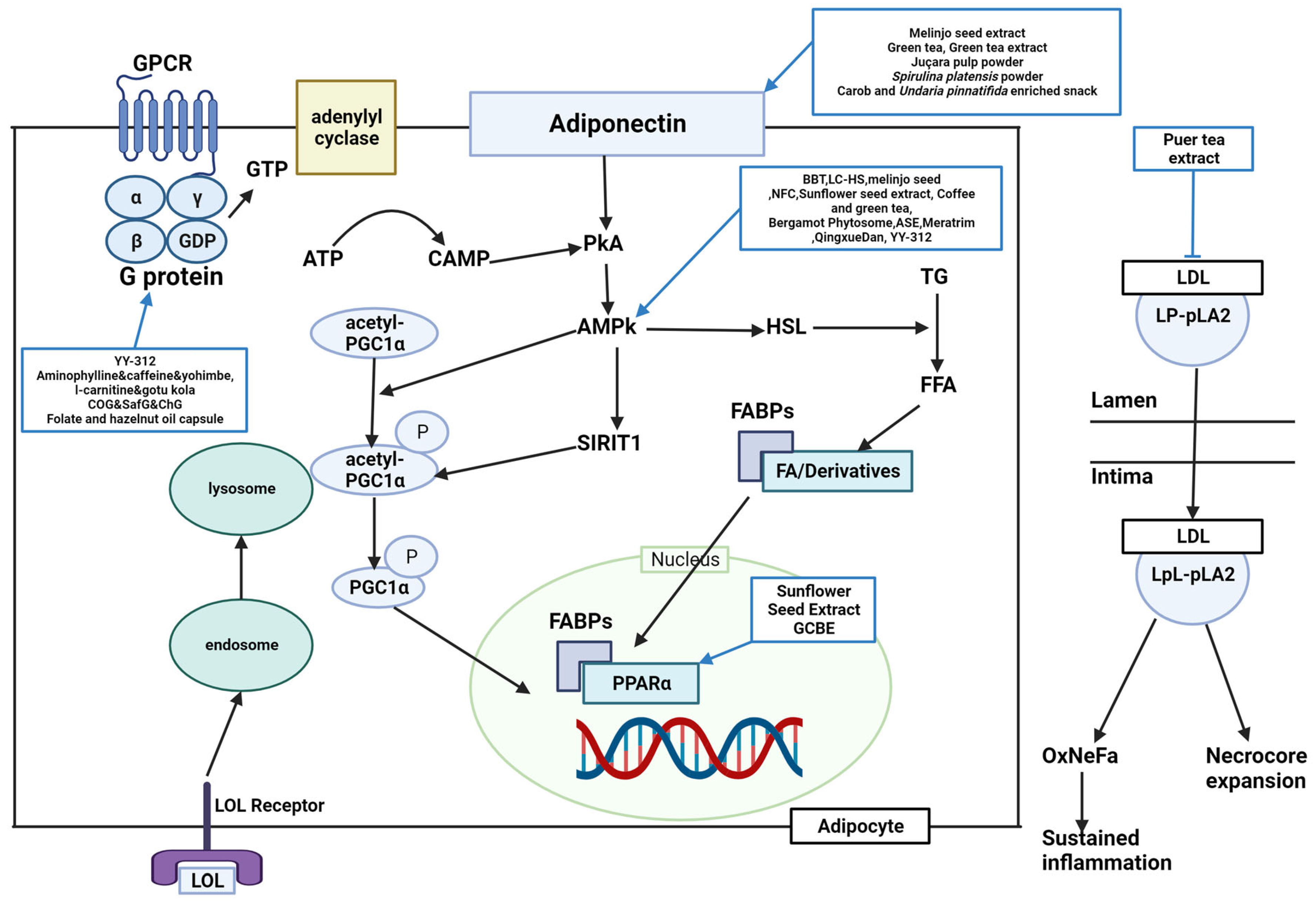
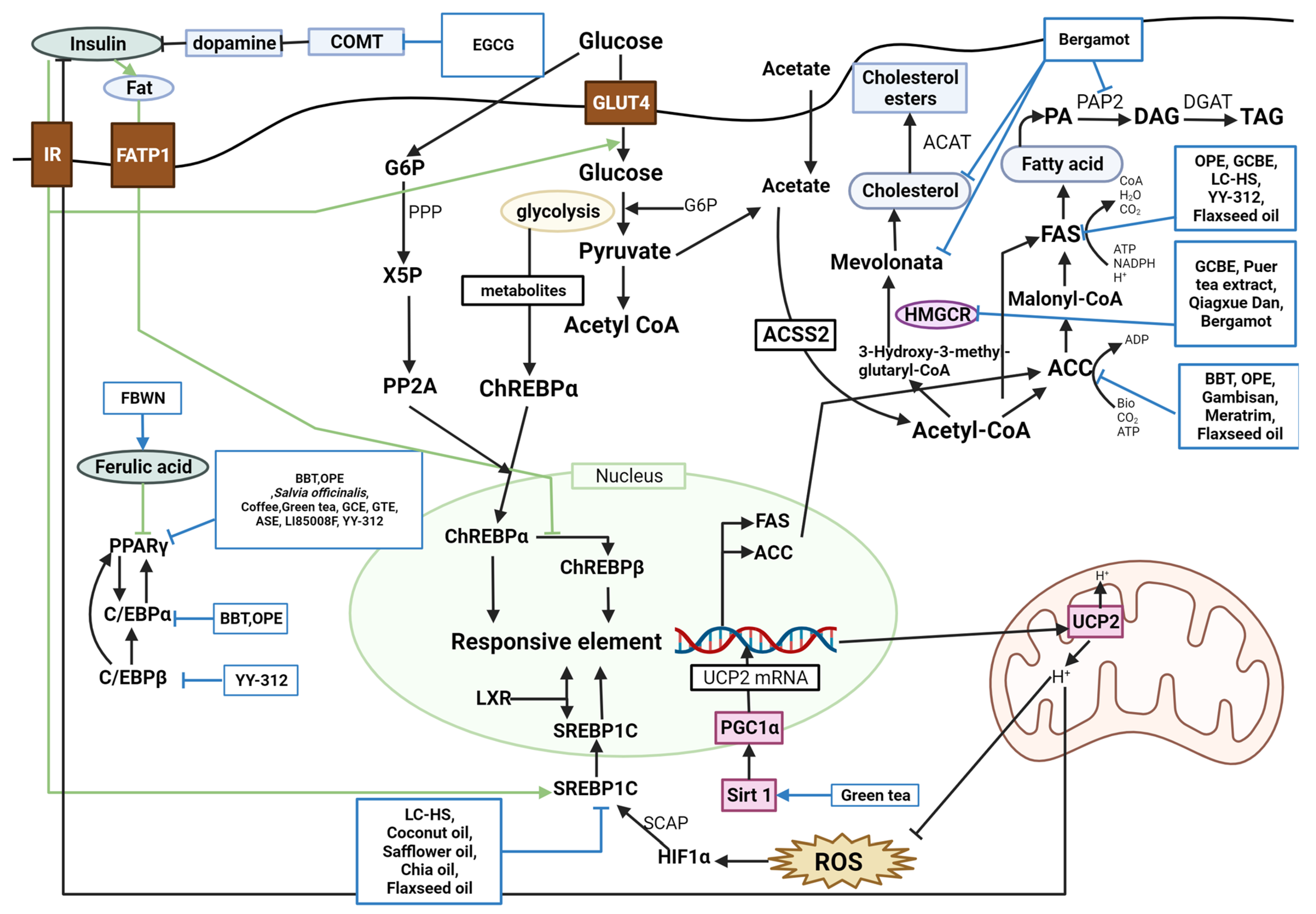
3.1.2. Anti-Inflammation
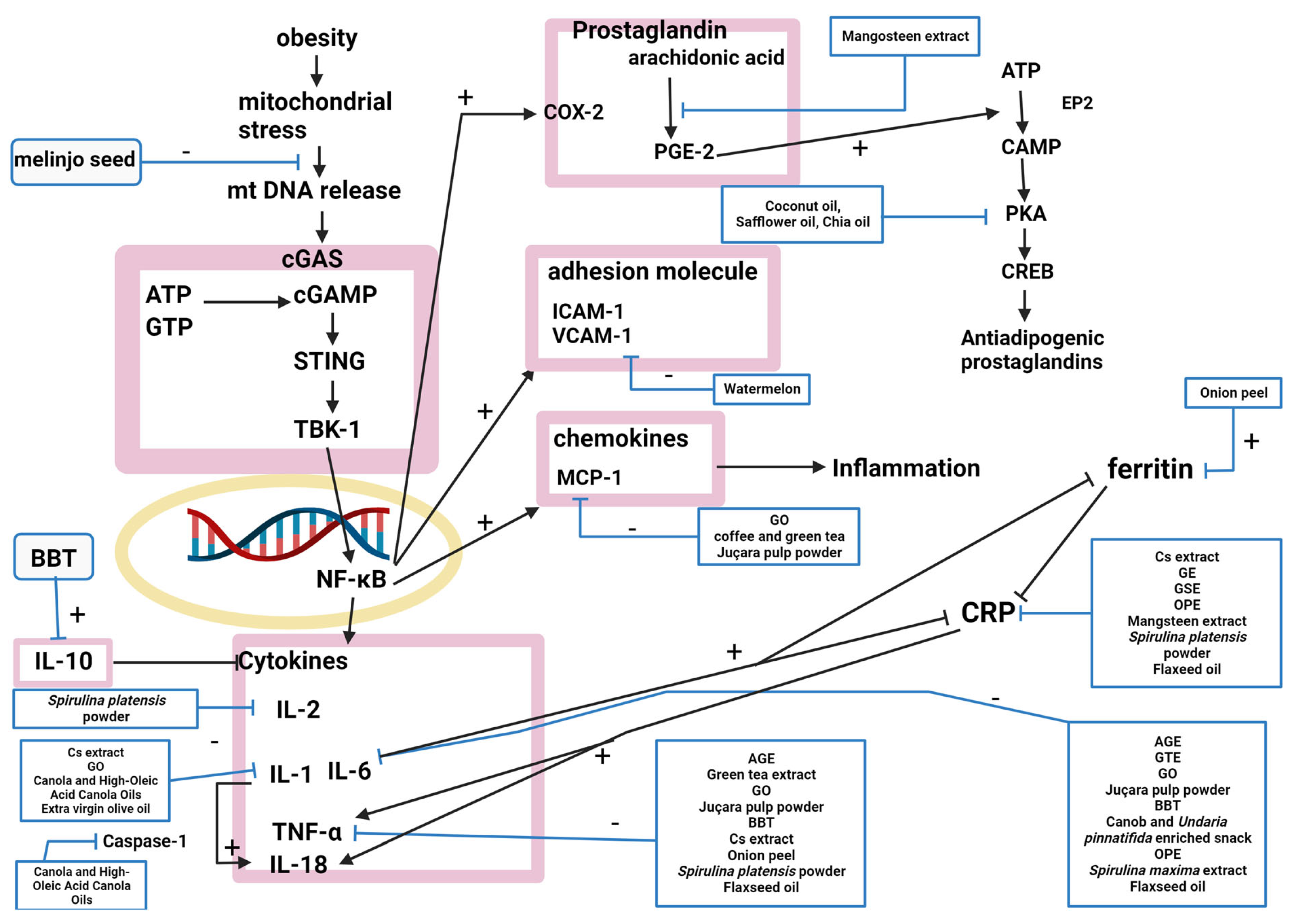
3.1.3. Antioxidant
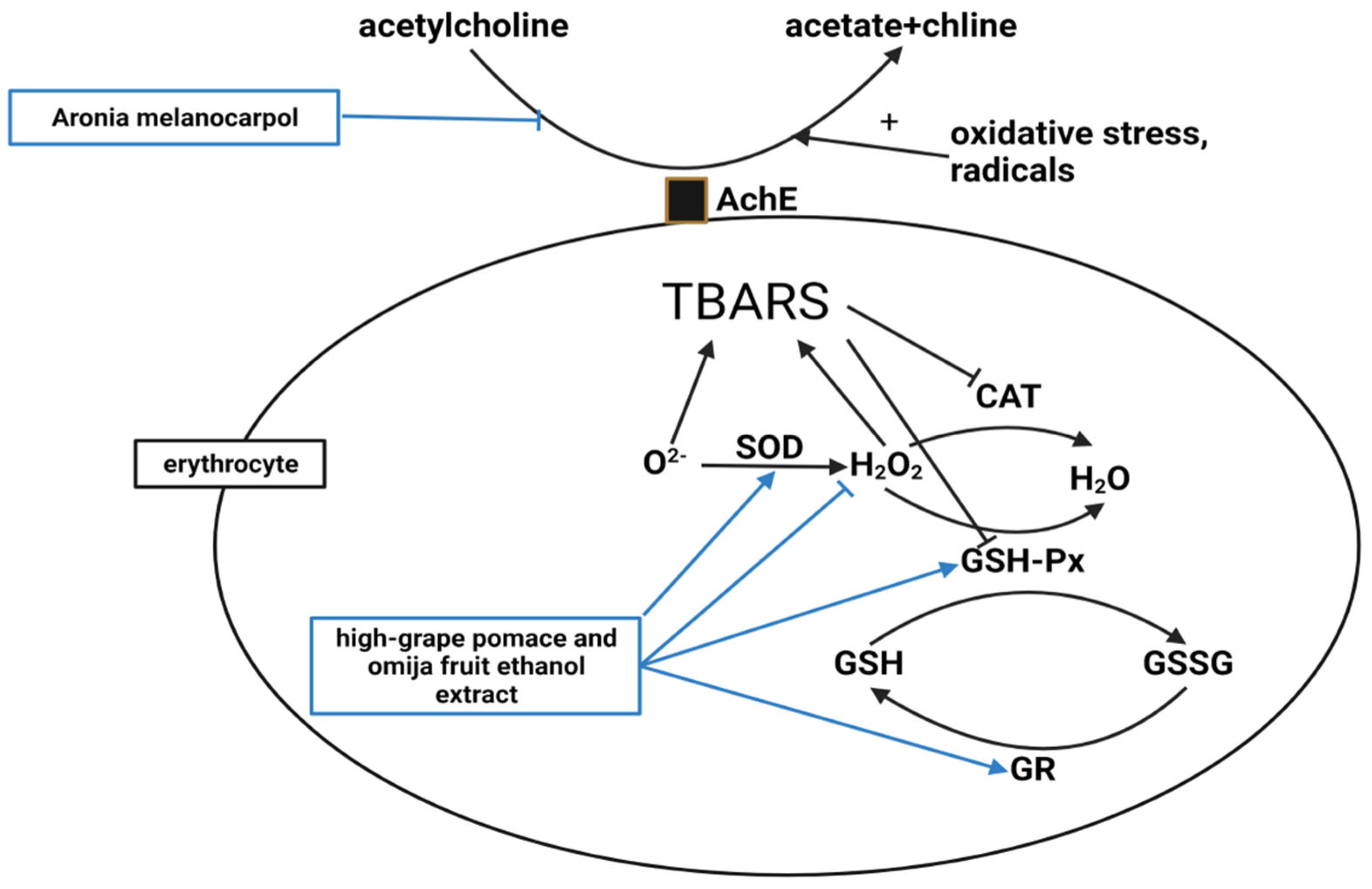
3.1.4. Appetite Loss
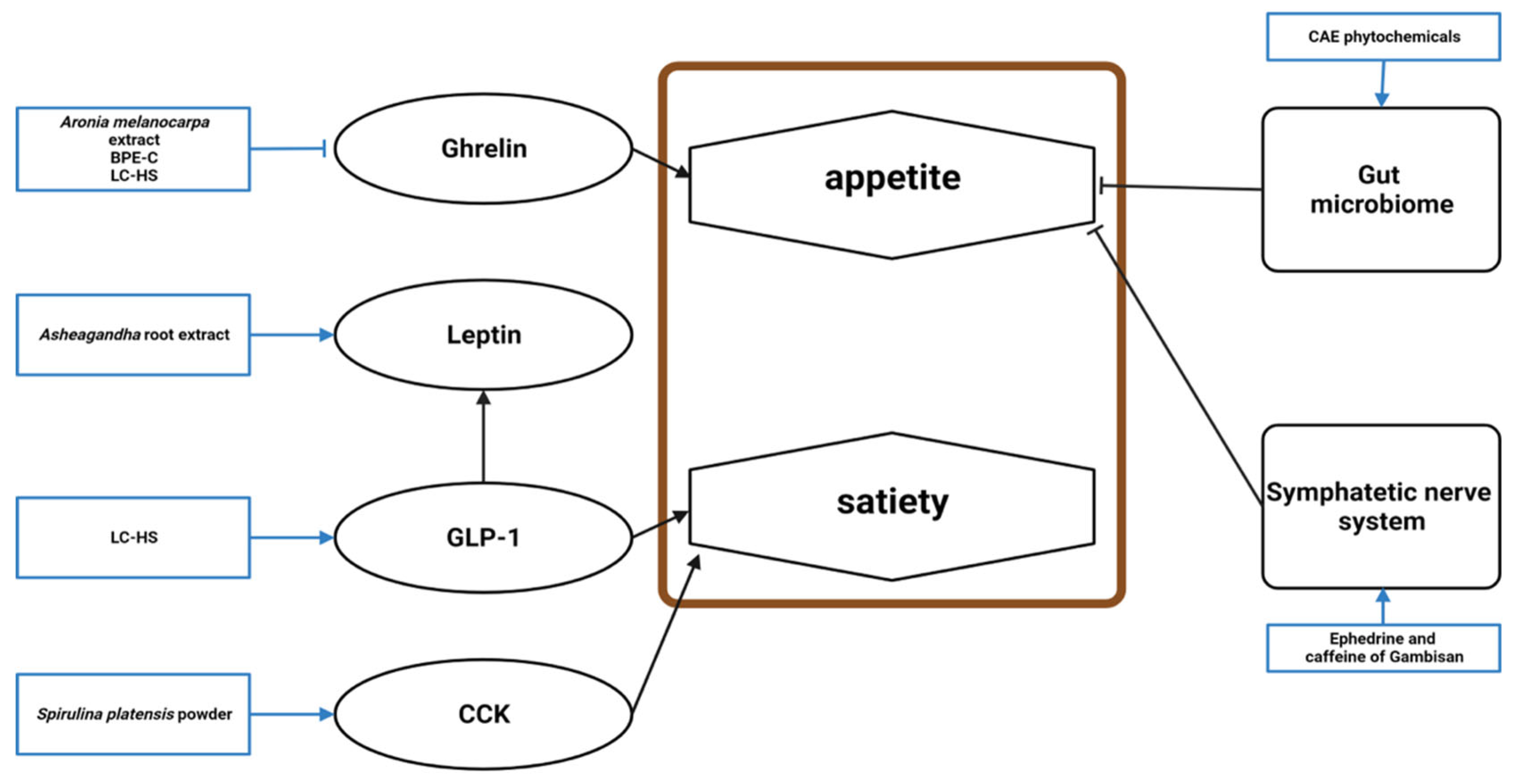
3.1.5. Thermogenesis
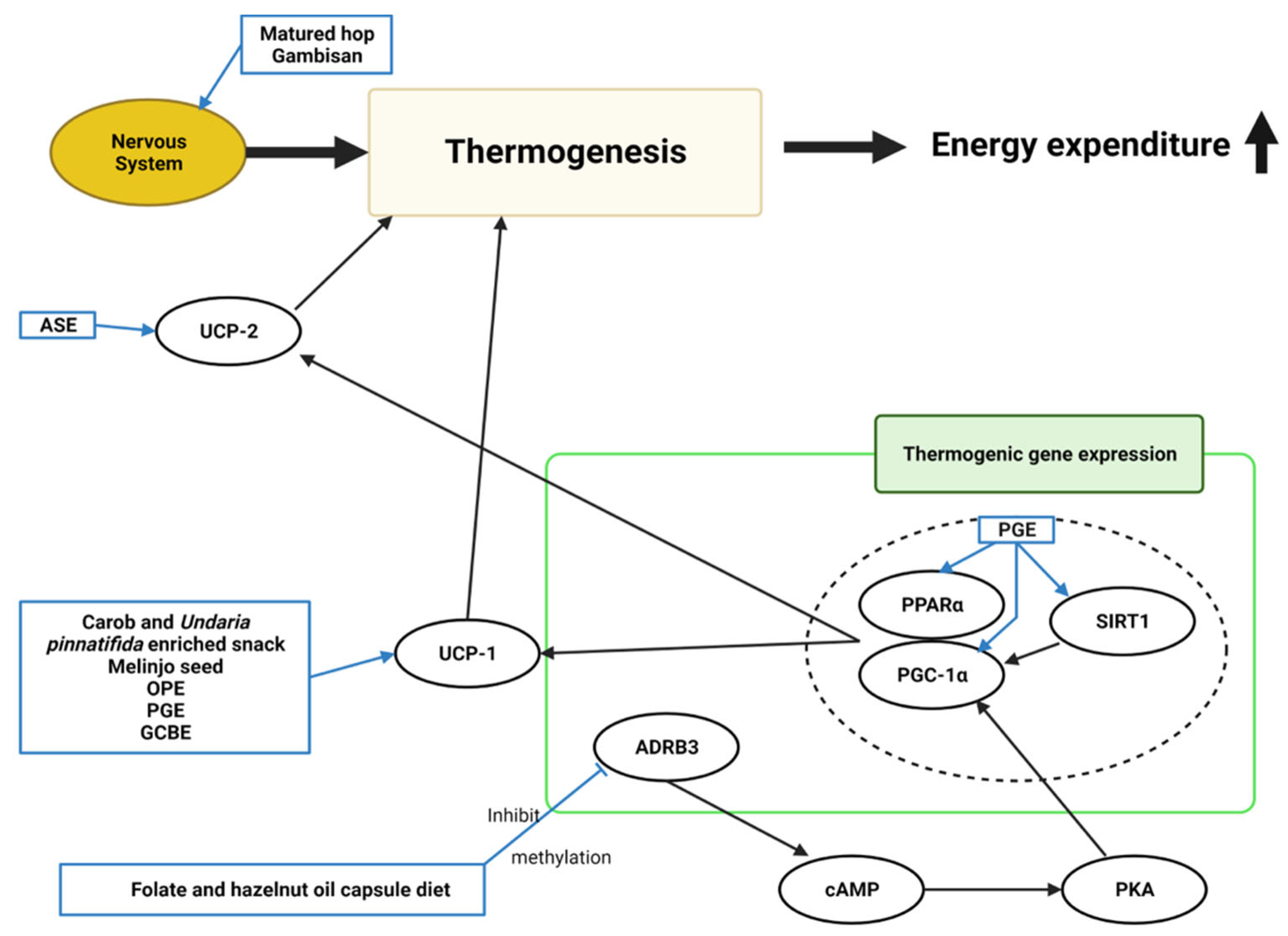
It is evident that various studies have examined the effects of natural products on obesity. This research detailed the potential for the widespread use of natural products in treating obesity, which has not been reported in previous reviews on the same topic. Further studies on safety, tolerability, and pharmacokinetics can be performed on these natural products to confirm their potential effectiveness. Natural compounds, foods, tea, fruit, extracts, decoctions, and external preparations were found to show efficacy in lipid metabolism, anti-inflammation, antioxidation, appetite loss, and thermogenesis. Most studies showed positive effects in relieving the symptoms of obesity and demonstrated that natural products could be used as effective treatments for obesity. Therefore, herbal medicines are expected to be fully utilized in clinical obesity treatment. However, limitations remain in that some studies did not investigate efficacy or safety, and their nonsignificant results could be changed with precise control of drug dosages. Therefore, meta-analyses are needed to further examine their findings. Further studies are expected to refine the pharmacological effects of natural products for clinical use.
References
- World Health Organization. Obesity. Available online: https://www.who.int/health-topics/obesity#tab=tab_1 (accessed on 22 November 2022).
- Kim, K.-S.; Yang, H.J.; Choi, E.-K.; Shin, M.H.; Kim, K.-H.; Um, J.Y.; Lee, B.-C.; Jang, H.-J. The effects of complex herbal medicine composed of Cornus fructus, Dioscoreae rhizoma, Aurantii fructus, and Mori folium in obese type-2 diabetes mice model. Orient. Pharm. Exp. Med. 2013, 13, 69–75.
- World Health Organization. World Obesity Day 2022—Accelerating Action to Stop Obesity. Available online: https://www.who.int/news/item/04-03-2022-world-obesity-day-2022-accelerating-action-to-stop-obesity (accessed on 22 November 2022).
- Centers for Disease Control and Preservation. Health Effects of Overweight and Obesity. Available online: https://www.cdc.gov/healthyweight/effects/index.html (accessed on 22 November 2022).
- National Institute of Diabetes and Digestive and Kidney Diseases. Prescription Medications to Treat Overweight & Obesity. Available online: https://www.niddk.nih.gov/health-information/weight-management/prescription-medications-treat-overweight-obesity (accessed on 22 November 2022).
- Tak, Y.J.; Lee, S.Y. Long-Term Efficacy and Safety of Anti-Obesity Treatment: Where Do We Stand? Curr. Obes. Rep. 2021, 10, 14–30.
- Lee, S.E.; Lim, C.; Lim, S.; Lee, B.; Cho, S. Effect of Ephedrae Herba methanol extract on high-fat diet-induced hyperlipidaemic mice. Pharm. Biol. 2019, 57, 676–683.
- Streeper, R.T.; Louden, C.; Izbicka, E. Oral Azelaic Acid Ester Decreases Markers of Insulin Resistance in Overweight Human Male Subjects. In Vivo 2020, 34, 1173–1186.
- Xu, C.; Mathews, A.E.; Rodrigues, C.; Eudy, B.J.; Rowe, C.A.; O’Donoughue, A.; Percival, S.S. Aged garlic extract supplementation modifies inflammation and immunity of adults with obesity: A randomized, double-blind, placebo-controlled clinical trial. Clin. Nutr. ESPEN 2018, 24, 148–155.
- Ferro, Y.; Montalcini, T.; Mazza, E.; Foti, D.; Angotti, E.; Gliozzi, M.; Nucera, S.; Paone, S.; Bombardelli, E.; Aversa, I.; et al. Randomized Clinical Trial: Bergamot Citrus and Wild Cardoon Reduce Liver Steatosis and Body Weight in Non-diabetic Individuals Aged Over 50 Years. Front. Endocrinol. 2020, 11, 494.
- Lee, M.; Sorn, S.R.; Park, Y.; Park, H.K. Anthocyanin Rich-Black Soybean Testa Improved Visceral Fat and Plasma Lipid Profiles in Overweight/Obese Korean Adults: A Randomized Controlled Trial. J. Med. Food 2016, 19, 995–1003.
- Kazemipoor, M.; Hamzah, S.; Hajifaraji, M.; Radzi, C.W.; Cordell, G.A. Slimming and Appetite-Suppressing Effects of Caraway Aqueous Extract as a Natural Therapy in Physically Active Women. Phytother. Res. 2016, 30, 981–987.
- Izaola, O.; Primo, D.; Rico Bargués, D.; Martín-Diana, A.B.; Martínez Villaluenga, C.; Miranda, J.; de Luis Román, D.A. Effects of a snack enriched with carob and Undaria pinnatifida (wakame) on metabolic parameters in a double blind, randomized clinical trial in obese patients. Nutr. Hosp. 2020, 34, 465–473.
- Rondanelli, M.; Riva, A.; Petrangolini, G.; Allegrini, P.; Bernardinelli, L.; Fazia, T.; Peroni, G.; Gasparri, C.; Nichetti, M.; Faliva, M.A.; et al. The Metabolic Effects of Cynara Supplementation in Overweight and Obese Class I Subjects with Newly Detected Impaired Fasting Glycemia: A Double-Blind, Placebo-Controlled, Randomized Clinical Trial. Nutrients 2020, 12, 3298.
- Szulińska, M.; Kręgielska-Narożna, M.; Świątek, J.; Styś, P.; Kuźnar-Kamińska, B.; Jakubowski, H.; Walkowiak, J.; Bogdański, P. Garlic extract favorably modifies markers of endothelial function in obese patients—Randomized double blind placebo-controlled nutritional intervention. Biomed. Pharmacother. 2018, 102, 792–797.
- Parandoosh, M.; Yousefi, R.; Khorsandi, H.; Nikpayam, O.; Saidpour, A.; Babaei, H. The effects of grape seed extract (Vitis vinifera) supplement on inflammatory markers, neuropeptide Y, anthropometric measures, and appetite in obese or overweight individuals: A randomized clinical trial. Phytother. Res. 2020, 34, 379–387.
- Pan, R.; Xu, T.; Bai, J.; Xia, S.; Liu, Q.; Li, J.; Xiao, X.; Dong, Y. Effect of Lactobacillus plantarum fermented barley on plasma glycolipids and insulin sensitivity in subjects with metabolic syndrome. J. Food Biochem. 2020, 44, e13471.
- Boix-Castejón, M.; Herranz-López, M.; Pérez Gago, A.; Olivares-Vicente, M.; Caturla, N.; Roche, E.; Micol, V. Hibiscus and lemon verbena polyphenols modulate appetite-related biomarkers in overweight subjects: A randomized controlled trial. Food Funct. 2018, 9, 3173–3184.
- Morimoto-Kobayashi, Y.; Ohara, K.; Ashigai, H.; Kanaya, T.; Koizumi, K.; Manabe, F.; Kaneko, Y.; Taniguchi, Y.; Katayama, M.; Kowatari, Y.; et al. Matured hop extract reduces body fat in healthy overweight humans: A randomized, double-blind, placebo-controlled parallel group study. Nutr. J. 2016, 15, 25.
- Oniki, K.; Kawakami, T.; Nakashima, A.; Miyata, K.; Watanabe, T.; Fujikawa, H.; Nakashima, R.; Nasu, A.; Eto, Y.; Takahashi, N.; et al. Melinjo seed extract increases adiponectin multimerization in physiological and pathological conditions. Sci. Rep. 2020, 10, 4313.
- Rao, A.S.; Hegde, S.; Pacioretty, L.M.; DeBenedetto, J.; Babish, J.G. Nigella sativa and Trigonella foenum-graecum Supplemented Chapatis Safely Improve HbA1c, Body Weight, Waist Circumference, Blood Lipids, and Fatty Liver in Overweight and Diabetic Subjects: A Twelve-Week Safety and Efficacy Study. J. Med. Food 2020, 23, 905–919.
- Choi, H.N.; Choue, R.; Park, Y.; Yim, J.E. Onion Peel Extract Increases Erythrocyte Membrane n-3 Fatty Acids in Overweight and Obese Korean Subjects. J. Med. Food 2020, 23, 37–42.
- Kim, Y.J.; Kwon, E.Y.; Kim, J.W.; Lee, Y.; Ryu, R.; Yun, J.; Kim, M.; Choi, M.S. Intervention Study on the Efficacy and Safety of Platycodon grandiflorus Ethanol Extract in Overweight or Moderately Obese Adults: A Single-Center, Randomized, Double-Blind, Placebo-Controlled Trial. Nutrients 2019, 11, 2445.
- Nishimura, M.; Muro, T.; Kobori, M.; Nishihira, J. Effect of Daily Ingestion of Quercetin-Rich Onion Powder for 12 Weeks on Visceral Fat: A Randomised, Double-Blind, Placebo-Controlled, Parallel-Group Study. Nutrients 2019, 12, 91.
- Amini, L.; Mojab, F.; Jahanfar, S.; Sepidarkish, M.; Raoofi, Z.; Maleki-Hajiagha, A. Efficacy of Salvia officinalis extract on the prevention of insulin resistance in euglycemic patients with polycystic ovary syndrome: A double-blinded placebo-controlled clinical trial. Complement. Ther. Med. 2020, 48, 102245.
- Maia-Landim, A.; Ramírez, J.M.; Lancho, C.; Poblador, M.S.; Lancho, J.L. Long-term effects of Garcinia cambogia/Glucomannan on weight loss in people with obesity, PLIN4, FTO and Trp64Arg polymorphisms. BMC Complement. Altern. Med. 2018, 18, 26.
- Farhat, G.; Berset, V.; Moore, L. Effects of Stevia Extract on Postprandial Glucose Response, Satiety and Energy Intake: A Three-Arm Crossover Trial. Nutrients 2019, 11, 3036.
- Leverrier, A.; Daguet, D.; Calame, W.; Dhoye, P.; Kodimule, S.P. Helianthus annuus Seed Extract Affects Weight and Body Composition of Healthy Obese Adults during 12 Weeks of Consumption: A Randomized, Double-Blind, Placebo-Controlled Pilot Study. Nutrients 2019, 11, 1080.
- Shanely, R.A.; Zwetsloot, J.J.; Jurrissen, T.J.; Hannan, L.C.; Zwetsloot, K.A.; Needle, A.R.; Bishop, A.E.; Wu, G.; Perkins-Veazie, P. Daily watermelon consumption decreases plasma sVCAM-1 levels in overweight and obese postmenopausal women. Nutr. Res. 2020, 76, 9–19.
- Permatasari, H.K.; Nurkolis, F.; Hardinsyah, H.; Taslim, N.A.; Sabrina, N.; Ibrahim, F.M.; Visnu, J.; Kumalawati, D.A.; Febriana, S.A.; Sudargo, T.; et al. Metabolomic Assay, Computational Screening, and Pharmacological Evaluation of Caulerpa racemosa as an Anti-obesity With Anti-aging by Altering Lipid Profile and Peroxisome Proliferator-Activated Receptor-γ Coactivator 1-α Levels. Front. Nutr. 2022, 9, 1412.
- Majeed, M.; Nagabhushanam, K.; Bhat, B.; Ansari, M.; Pandey, A.; Bani, S.; Mundkur, L. The Anti-Obesity Potential of Cyperus rotundus Extract Containing Piceatannol, Scirpusin A and Scirpusin B from Rhizomes: Preclinical and Clinical Evaluations. Diabetes. Metab. Syndr. Obes. 2022, 15, 369–382.
- Tomar, M.; Rao, R.P.; Dorairaj, P.; Koshta, A.; Suresh, S.; Rafiq, M.; Kumawat, R.; Paramesh, R.; Bu, V.; Venkatesh, K.V. A clinical and computational study on anti-obesity effects of hydroxycitric acid. RSC Adv. 2019, 9, 18578–18588, Erratum in RSC Adv. 2019, 9, 22288.
- Han, H.-S.; Chung, K.-S.; Shin, Y.-K.; Yu, J.-S.; Kang, S.-H.; Lee, S.-H.; Lee, K.-T. Effect of Standardized Hydrangea serrata (Thunb.) Ser. Leaves Extract on Body Weight and Body Fat Reduction in Overweight or Obese Humans: A Randomized Double-Blind Placebo-Controlled Study. Nutrients 2022, 14, 208.
- Lin, Y.K.; Chung, Y.M.; Yang, H.T.; Lin, Y.H.; Lin, Y.H.; Hu, W.C.; Chiang, C.F. The potential of immature poken (Citrus reticulata) extract in the weight management, lipid and glucose metabolism. J. Complement. Integr. Med. 2021, 19, 279–285.
- Yonekura, Y.; Terauchi, M.; Hirose, A.; Odai, T.; Kato, K.; Miyasaka, N. Daily Coffee and Green Tea Consumption Is Inversely Associated with Body Mass Index, Body Fat Percentage, and Cardio-Ankle Vascular Index in Middle-Aged Japanese Women: A Cross-Sectional Study. Nutrients 2020, 12, 1370.
- Ghasemi, E.; Afzalpour, M.E.; Nayebifar, S. Combined high-intensity interval training and green tea supplementation enhance metabolic and antioxidant status in response to acute exercise in overweight women. J. Physiol. Sci. 2020, 70, 31.
- Kobayashi, M.; Kawano, T.; Ukawa, Y.; Sagesaka, Y.M.; Fukuhara, I. Green tea beverages enriched with catechins with a galloyl moiety reduce body fat in moderately obese adults: A randomized double-blind placebo-controlled trial. Food Funct. 2016, 7, 498–507.
- Koyama, T.; Maekawa, M.; Ozaki, E.; Kuriyama, N.; Uehara, R. Daily Consumption of Coffee and Eating Bread at Breakfast Time Is Associated with Lower Visceral Adipose Tissue and with Lower Prevalence of Both Visceral Obesity and Metabolic Syndrome in Japanese Populations: A Cross-Sectional Study. Nutrients 2020, 12, 3090.
- Roshan, H.; Nikpayam, O.; Sedaghat, M.; Sohrab, G. Effects of green coffee extract supplementation on anthropometric indices, glycaemic control, blood pressure, lipid profile, insulin resistance and appetite in patients with the metabolic syndrome: A randomised clinical trial. Br. J. Nutr. 2018, 119, 250–258.
- Haidari, F.; Samadi, M.; Mohammadshahi, M.; Jalali, M.T.; Engali, K.A. Energy restriction combined with green coffee bean extract affects serum adipocytokines and the body composition in obese women. Asia Pac. J. Clin. Nutr. 2017, 26, 1048–1054.
- Bagheri, R.; Rashidlamir, A.; Ashtary-Larky, D.; Wong, A.; Grubbs, B.; Motevalli, M.S.; Baker, J.S.; Laher, I.; Zouhal, H. Effects of green tea extract supplementation and endurance training on irisin, pro-inflammatory cytokines, and adiponectin concentrations in overweight middle-aged men. Eur. J. Appl. Physiol. 2020, 120, 915–923.
- Chen, I.J.; Liu, C.Y.; Chiu, J.P.; Hsu, C.H. Therapeutic effect of high-dose green tea extract on weight reduction: A randomized, double-blind, placebo-controlled clinical trial. Clin. Nutr. 2016, 35, 592–599.
- Katanasaka, Y.; Miyazaki, Y.; Sunagawa, Y.; Funamoto, M.; Shimizu, K.; Shimizu, S.; Sari, N.; Shimizu, Y.; Wada, H.; Hasegawa, K.; et al. Kosen-cha, a Polymerized Catechin-Rich Green Tea, as a Potential Functional Beverage for the Reduction of Body Weight and Cardiovascular Risk Factors: A Pilot Study in Obese Patients. Biol. Pharm. Bull. 2020, 43, 675–681.
- Zhang, S.; Takano, J.; Murayama, N.; Tominaga, M.; Abe, T.; Park, I.; Seol, J.; Ishihara, A.; Tanaka, Y.; Yajima, K.; et al. Subacute Ingestion of Caffeine and Oolong Tea Increases Fat Oxidation without Affecting Energy Expenditure and Sleep Architecture: A Randomized, Placebo-Controlled, Double-Blinded Cross-Over Trial. Nutrients 2020, 12, 3671.
- Jensen, G.S.; Beaman, J.L.; He, Y.; Guo, Z.; Sun, H. Reduction of body fat and improved lipid profile associated with daily consumption of a Puer tea extract in a hyperlipidemic population: A randomized placebo-controlled trial. Clin. Interv. Aging 2016, 11, 367–376.
- Duchnowicz, P.; Ziobro, A.; Rapacka, E.; Koter-Michalak, M.; Bukowska, B. Changes in Cholinesterase Activity in Blood of Adolescent with Metabolic Syndrome after Supplementation with Extract from Aronia melanocarpa. Biomed. Res. Int. 2018, 2018, 5670145.
- Rondanelli, M.; Peroni, G.; Riva, A.; Petrangolini, G.; Allegrini, P.; Fazia, T.; Bernardinelli, L.; Naso, M.; Faliva, M.A.; Tartara, A.; et al. Bergamot phytosome improved visceral fat and plasma lipid profiles in overweight and obese class I subject with mild hypercholesterolemia: A randomized placebo controlled trial. Phytother. Res. 2021, 35, 2045–2056.
- Capomolla, A.S.; Janda, E.; Paone, S.; Parafati, M.; Sawicki, T.; Mollace, R.; Ragusa, S.; Mollace, V. Atherogenic Index Reduction and Weight Loss in Metabolic Syndrome Patients Treated with A Novel Pectin-Enriched Formulation of Bergamot Polyphenols. Nutrients 2019, 11, 1271.
- Cai, Y.; Xing, G.; Shen, T.; Zhang, S.; Rao, J.; Shi, R. Effects of 12-week supplementation of Citrus bergamia extracts-based formulation CitriCholess on cholesterol and body weight in older adults with dyslipidemia: A randomized, double-blind, placebo-controlled trial. Lipids Health Dis. 2017, 16, 251.
- Han, H.J.; Jung, U.J.; Kim, H.J.; Cho, S.J.; Kim, A.H.; Han, Y.; Choi, M.S. Combined Supplementation with Grape Pomace and Omija Fruit Ethanol Extracts Dose-Dependently Improves Body Composition, Plasma Lipid Profiles, Inflammatory Status, and Antioxidant Capacity in Overweight and Obese Subjects. J. Med. Food. 2016, 19, 170–180.
- Jamar, G.; Santamarina, A.B.; Flygare, A.C.; Gagliardi, A.; de Rosso, V.V.; Dourado, V.Z.; Pisani, L.P. Effects of the juçara fruit supplementation on metabolic parameters in individuals with obesity: A double-blind randomized controlled trial. J. Nutr. Biochem. 2020, 83, 108430.
- Watanabe, M.; Gangitano, E.; Francomano, D.; Addessi, E.; Toscano, R.; Costantini, D.; Tuccinardi, D.; Mariani, S.; Basciani, S.; Spera, G.; et al. Mangosteen Extract Shows a Potent Insulin Sensitizing Effect in Obese Female Patients: A Prospective Randomized Controlled Pilot Study. Nutrients 2018, 10, 586.
- Chooi, Y.C.; Ding, C.; Magkos, F. The epidemiology of obesity. Metab. Clin. Exp. 2019, 92, 6–10.
- Cho, I.J.; Choung, S.Y.; Hwang, Y.C.; Ahn, K.J.; Chung, H.Y.; Jeong, I.K. Aster spathulifolius Maxim extract reduces body weight and fat mass in obese humans. Nutr. Res. 2016, 36, 671–678.
- Cho, Y.G.; Jung, J.H.; Kang, J.H.; Kwon, J.S.; Yu, S.P.; Baik, T.G. Effect of a herbal extract powder (YY-312) from Imperata cylindrica Beauvois, Citrus unshiu Markovich, and Evodia officinalis Dode on body fat mass in overweight adults: A 12-week, randomized, double-blind, placebo-controlled, parallel-group clinical trial. BMC Complement. Altern. Med. 2017, 17, 375.
- Dixit, K.; Kamath, D.V.; Alluri, K.V.; Davis, B.A. Efficacy of a novel herbal formulation for weight loss demonstrated in a 16-week randomized, double-blind, placebo-controlled clinical trial with healthy overweight adults. Diabetes Obes. Metab. 2018, 20, 2633–2641.
- Kudiganti, V.; Kodur, R.R.; Kodur, S.R.; Halemane, M.; Deep, D.K. Efficacy and tolerability of Meratrim for weight management: A randomized, double-blind, placebo-controlled study in healthy overweight human subjects. Lipids Health Dis. 2016, 15, 136.
- Jo, D.H.; Lee, S.; Lee, J.D. Effects of Gambisan in overweight adults and adults with obesity: A retrospective chart review. Medicine 2019, 98, e18060.
- Rezaei, S.; Sasani, M.R.; Akhlaghi, M.; Kohanmoo, A. Flaxseed oil in the context of a weight loss programme ameliorates fatty liver grade in patients with non-alcoholic fatty liver disease: A randomised double-blind controlled trial. Br. J. Nutr. 2020, 123, 994–1002.
- Herranz-López, M.; Olivares-Vicente, M.; Boix-Castejón, M.; Caturla, N.; Roche, E.; Micol, V. Differential effects of a combination of Hibiscus sabdariffa and Lippia citriodora polyphenols in overweight/obese subjects: A randomized controlled trial. Sci. Rep. 2019, 9, 2999.
- Chung, W.; Ryu, J.; Chung, S.; Kim, S. Effect of Qingxue Dan on obesity and metabolic biomarker: A double-blind randomized-controlled pilot study. J. Tradit. Chin. Med. 2016, 36, 291–298.
- Yousefi, R.; Mottaghi, A.; Saidpour, A. Spirulina platensis effectively ameliorates anthropometric measurements and obesity-related metabolic disorders in obese or overweight healthy individuals: A randomized controlled trial. Complement. Ther. Med. 2018, 40, 106–112.
- Oliveira-de-Lira, L.; Santos, E.M.C.; de Souza, R.F.; Matos, R.J.B.; Silva, M.C.D.; Oliveira, L.D.S.; Nascimento, T.G.D.; Schemly, P.; Souza, S.L. Supplementation-Dependent Effects of Vegetable Oils with Varying Fatty Acid Compositions on Anthropometric and Biochemical Parameters in Obese Women. Nutrients 2018, 10, 932.
- Escalante, G.; Bryan, P.; Rodriguez, J. Effects of a topical lotion containing aminophylline, caffeine, yohimbe, l-carnitine, and gotu kola on thigh circumference, skinfold thickness, and fat mass in sedentary females. J. Cosmet. Dermatol. 2019, 18, 1037–1043.
- Lima, R.P.A.; do Nascimento, R.A.F.; Luna, R.C.P.; Persuhn, D.C.; da Silva, A.S.; da Conceição Rodrigues Gonçalves, M.; de Almeida, A.T.C.; de Moraes, R.M.; Junior, E.V.; Fouilloux-Meugnier, E.; et al. Effect of a diet containing folate and hazelnut oil capsule on the methylation level of the ADRB3 gene, lipid profile and oxidative stress in overweight or obese women. Clin. Epigenetics 2017, 9, 110.
- Szulinska, M.; Gibas-Dorna, M.; Miller-Kasprzak, E.; Suliburska, J.; Miczke, A.; Walczak-Gałezewska, M.; Stelmach-Mardas, M.; Walkowiak, J.; Bogdanski, P. Spirulina maxima improves insulin sensitivity, lipid profile, and total antioxidant status in obese patients with well-treated hypertension: A randomized double-blind placebo-controlled study. Eur. Rev. Med. Pharmacol. Sci. 2017, 21, 2473–2481.
- Galvão Cândido, F.; Xavier Valente, F.; da Silva, L.E.; Gonçalves Leão Coelho, O.; Gouveia Peluzio, M.D.C.; Gonçalves Alfenas, R.C. Consumption of extra virgin olive oil improves body composition and blood pressure in women with excess body fat: A randomized, double-blinded, placebo-controlled clinical trial. Eur. J. Nutr. 2018, 57, 2445–2455.
- Liu, X.; Kris-Etherton, P.M.; West, S.G.; Lamarche, B.; Jenkins, D.J.; Fleming, J.A.; McCrea, C.E.; Pu, S.; Couture, P.; Connelly, P.W.; et al. Effects of canola and high-oleic-acid canola oils on abdominal fat mass in individuals with central obesity. Obesity 2016, 24, 2261–2268.
- Choudhary, D.; Bhattacharyya, S.; Joshi, K. Body Weight Management in Adults Under Chronic Stress Through Treatment With Ashwagandha Root Extract: A Double-Blind, Randomized, Placebo-Controlled Trial. J. Evid. Based Complement. Altern. Med. 2017, 22, 96–106.




